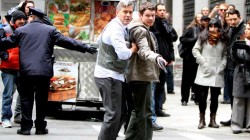Cinema | May 20th, 2016

“Money Monster” is Jodie Foster’s first feature directorial effort since 2011’s curiosity “The Beaver,” blending elements of social satire, bomb vest thriller, and conspiracy drama – all of it unfolding in close to real time. Stars George Clooney and Julia Roberts, reuniting in roles they can manage while asleep, play cable TV host Lee Gates and director Patty Fenn of the titular investment/infotainment spectacle. The two, along with the rest of their crew, are forced to continue a live broadcast after being taken hostage by a blue-collar janitor whose life savings vanished into the gaping jaws of Wall Street’s rigged system. Armed with a pistol and holding a dead man’s switch, Jack O’Connell’s Kyle Budwell demands the answers Foster will attempt to deliver.
With hints of old favorites like “Network” and “Dog Day Afternoon” looming over the wild, scattershot script by Alan Di Fiore, Jim Kouf, and Jamie Linden, “Money Monster” periodically evokes the edgy 1970s terrain of Sidney Lumet. The new film, no matter how admirably it attempts the kind of risks and outrageousness displayed in Lumet’s great movies, never reaches the level of scorching black comedy and penetrating critique demanded of a classic. Even so, “Money Monster” is as reliably entertaining as it is unrealistic and farfetched.
Foster’s inclusion of several humorous motifs and deliberately comical asides are initially surprising given the underlying seriousness of the David versus Goliath conflict at the film’s heart. In one off-the-rails scene, Gates cajoles his producer into applying an erectile cream that leads to some unexpected broom closet shenanigans. In several others, Foster smoothly upends expectations when humanity fails to embrace the better angels of our nature. While some critics have questioned Foster’s application of comedy, the movie’s sense of humor communicates a tonal lightness that fits the script’s breezier approach to the ongoing global financial crisis.
While “Money Monster” features a skewed ratio of male principal, secondary, and background actors, including a disappointingly underutilized Giancarlo Esposito, Foster makes room for several significant exchanges between named women characters addressing topics other than men. Roberts’ Fenn, whispering instructions to Gates through his IFB earpiece from her position in the control room, stays one step ahead of the deteriorating situation, piecing together components of the algorithm “glitch” with the help of “Outlander” star Caitriona Balfe’s Diane Lester, the CCO and spokesperson for the felonious financial organization that cheated its shareholders, including Budwell.
Two other women, Condola Rashad and Emily Meade (who completely steals her big scene), also provide memorable moments. Unlike “The Big Short,” another film that dealt with the unbelievable and unconscionable lack of ethics within banking institutions trusted to protect the interests of their clients, “Money Monster” won’t be remembered during award season. The demands of the action-oriented standoff tension, especially as the plot ramps up to a melodramatic climax, overshadow any potentially deep political critique. And no matter how many unnecessary side trips the movie makes to South Africa, South Korea, and Iceland, the best location is also the most intimate one: the electric signals sent from Fenn’s intercom microphone to Gates’ in-ear monitor on the studio set of “Money Monster.”
December 29th 2025
December 29th 2025
December 16th 2025
December 9th 2025
December 2nd 2025
_(1)_(1)_(1)__293px-wide.jpg)


__293px-wide.jpg)
_(1)__293px-wide.png)
_(1)__293px-wide.png)